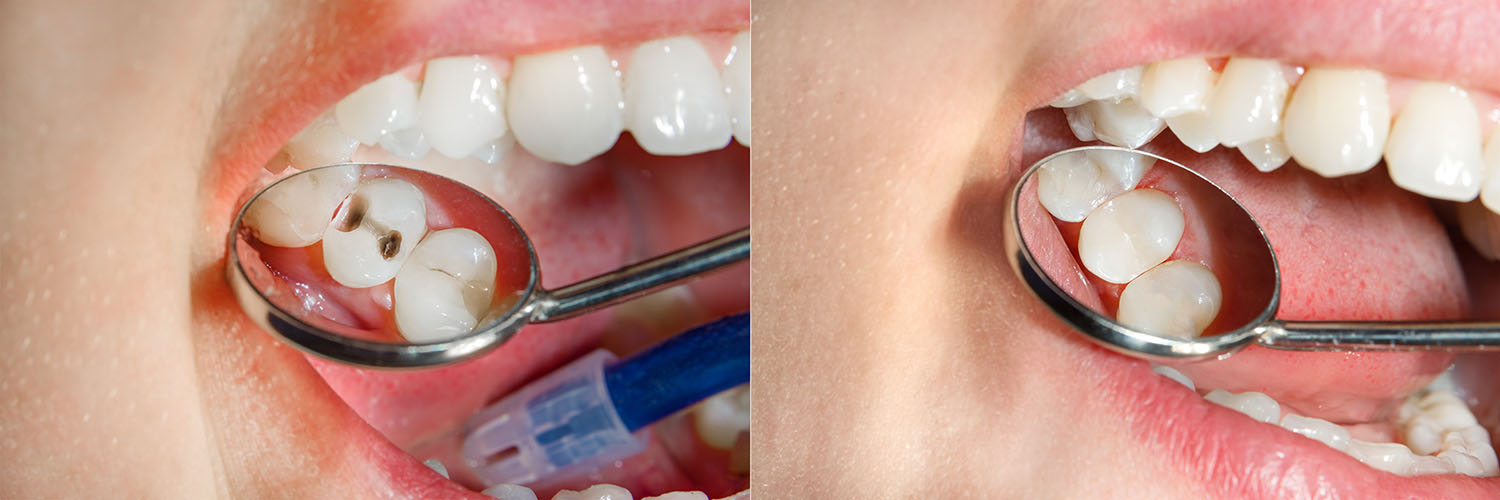
A dental filling does more than patch a small cavity — it restores the structure and function of a tooth so you can bite, chew, and smile with confidence. When decay or damage removes healthy tooth substance, the remaining enamel and dentin are vulnerable to further breakdown. Placing a properly designed restoration prevents the problem from growing into a deeper infection or the need for more extensive work like a crown or root canal.
Fillings are among the most commonly performed restorative procedures because they address a problem at its earliest clinically treatable stage. By removing decay and replacing lost tissue with a biocompatible material, a filling returns strength to the tooth and re-establishes a protective barrier against bacteria. Timely treatment can preserve the tooth for many years and helps avoid more invasive interventions.
In our approach to routine restorative care, we emphasize precision and comfort. We combine careful diagnosis, conservative tooth preparation, and modern materials to achieve results that are both durable and visually pleasing. At Seals Family Dentistry, our focus is to restore oral health while maintaining as much natural tooth structure as possible.
People have attempted to treat dental disease for millennia. Archaeological discoveries suggest that basic forms of tooth repair existed thousands of years ago, but the techniques and materials available to practitioners changed dramatically over time. The 19th and 20th centuries introduced metal-based restoratives, which brought strength and longevity to the practice of repairing teeth.
More recent decades have seen rapid innovation in dental materials science. Newer tooth-colored options allow clinicians to prioritize both form and function, giving patients restorations that blend seamlessly with the surrounding enamel while eliminating concerns associated with older metallic materials.
Every patient and every cavity are unique. Treatment planning begins with a careful assessment of the tooth’s remaining structure, the extent of decay, bite relationships, and esthetic expectations. We discuss the clinical benefits and limitations of each restoration so you can make an informed decision that fits your oral-health goals.

Today’s restorative dentistry offers several material options, each with distinct strengths. Some prioritize strength and longevity, while others emphasize esthetics and conservation of tooth structure. Understanding the differences helps you and your clinician choose a solution that balances appearance, performance, and long-term preservation.
The selection often depends on the tooth’s location, the size of the defect, and the stresses the restoration will encounter during chewing. For example, a large restoration on a back molar used for heavy chewing may call for a different material than a small front-tooth repair where appearance is paramount.
Advances in adhesive dentistry have expanded the use of tooth-colored materials that bond to enamel and dentin. Bonded restorations can strengthen weakened teeth, reduce the need for aggressive shaping, and create a natural-looking outcome that integrates with the rest of your smile.
Composite resins are a blend of durable polymers and glass-like fillers. Available in many shades, they allow restorations to match the natural color of the tooth. Because composite bonds to tooth structure, clinicians can often remove less healthy tissue during preparation, preserving more of the original tooth.
Composite restorations are versatile: beyond filling cavities, they are used for small reshaping, repairing chips, and improving a tooth’s appearance. Like any material, composites can show wear or staining over time and may need replacement depending on function and care.
Amalgam has a long clinical history of durability and resistance to wear. These restorations have served reliably for decades in high-stress areas. While they are less commonly chosen for cosmetic reasons, they remain a practical option when strength and longevity are the primary concerns.
Glass ionomer materials bond chemically to tooth structure and release fluoride over time, which can help strengthen the surrounding enamel. They’re often used for restorations in baby teeth, in areas near the gumline, or as a temporary restorative while a definitive solution is planned.
Ceramic restorations are fabricated from high-quality dental porcelain and offer excellent wear resistance and cosmetic results. Because they are made outside the mouth and bonded into place, ceramics can provide a precise fit and outstanding longevity in many cases.
Highly biocompatible and long-lasting, gold restorations are praised for their physical properties and gentle interaction with opposing teeth. Though used less often today due to esthetic preferences, gold remains a superb material when indicated by clinical needs.

The decision about which filling material to use is clinical and patient-centered. We evaluate the size and location of the lesion, the health of the surrounding tooth, your bite, and long-term goals for function and appearance. Some solutions are ideal for conservative repairs, while others are better suited for larger restorations or teeth under heavy load.
Your preferences also matter. Many people prioritize restorations that are visually indistinguishable from natural teeth; others prioritize durability above all else. We’ll review the expected lifespan, maintenance considerations, and how each material interacts with adjacent teeth so that you can choose with confidence.
Where appropriate, we’ll recommend treatments that protect as much healthy tooth as possible and set realistic expectations for longevity and care. Regular checkups and good oral hygiene go a long way toward extending the life of any restoration.
When treatment is recommended, the process is straightforward and focused on your comfort. After a thorough exam and any necessary x-rays, the area is numbed with local anesthesia so you should not feel discomfort during the procedure. We use minimally invasive techniques to remove decay and prepare the tooth for restoration.
The tools used to remove decay vary with the situation: high-speed instruments, air abrasion, or lasers may be used to selectively remove damaged tissue. For bonded materials, the tooth surface is prepared and conditioned so the restoration can adhere securely. For indirect restorations like inlays or onlays, impressions or digital scans are taken and the restoration is fabricated before being cemented or bonded in place at a follow-up appointment.
Typical appointments for direct fillings usually take under an hour, though more extensive cases or multiple restorations will require additional time. If dental anxiety is a concern, discuss sedation options with our team so we can help you feel relaxed and safe throughout your visit.
After a filling, short-term sensitivity is normal as the tooth adjusts. Most patients notice the numbness wear off within a couple of hours and any sensitivity fades over days to weeks. We provide specific post-treatment guidance so you know what to expect and how to protect the new restoration as it settles.
Good home care — regular brushing with fluoride toothpaste, daily flossing, and routine professional cleanings — helps keep restorations free from secondary decay. Avoiding habits that place excessive force on teeth, such as chewing ice or using teeth as tools, can extend the life of any filling.
If you experience persistent discomfort, a change in your bite, or notice a rough edge, contact the office so we can evaluate and make any needed adjustments. Early attention to minor issues often prevents more involved treatment later.
Important immediate-care reminders:
Protect numb soft tissues: Avoid chewing or hot drinks until sensation returns to prevent accidental injury.
Expect temporary sensitivity: Mild reactions to hot, cold, or pressure are common and typically resolve on their own.
Watch your bite: If your bite feels uneven or sore, a minor adjustment can usually correct it quickly.
Maintain hygiene: Routine oral care and dental visits help detect early wear or recurring decay so problems can be addressed promptly.

At Seals Family Dentistry, our goal is to provide clear guidance and restorative solutions that protect your oral health and preserve your smile. If you have questions about dental fillings, the best materials for your situation, or what to expect during treatment, please contact us for more information.

If the pleasure of eating a delicious bowl of ice cream or sipping a soothing cup of tea gets overshadowed by dental pain that makes you wince; it's time to contact our office. As skilled providers of care, we'll determine what's causing your discomfort and perform the treatment required to alleviate your symptoms and get you back on the road to oral health.
Cavities develop because of an infectious process that causes progressive damage to tooth structure. Despite starting as a pinpoint defect on the outermost enamel layer of your tooth, untreated dental decay progressively compromises more and more healthy tooth structure as it works its way to the inner layers of your tooth.
Yes, you can still develop tooth decay on other surfaces of the tooth, around the margins of an old filling, or in fewer instances, recurrent decay underneath it. For this reason, it's essential to maintain excellent oral hygiene, a diet low in sugary beverages and sweets, and be sure to visit our office for routine checkups and care. While tooth decay is second only to the common cold in frequency, it's almost entirely preventable.
We value the time and comfort of our patients. If cavities are located on adjacent teeth, or in the same section of your smile, it may be possible to treat more than one tooth during your visit. However, how much is done each visit depends on several factors. We keep our patients well informed and tailor every treatment plan and visit to address their unique needs.
Addressing concerns on the presence of elemental mercury in silver fillings, the American Dental Association (ADA), The Center for Disease Control and Prevention (CDC), the FDA, and the World Health Organization have all stated that amalgam restorations do not pose a risk to health. However, individuals with allergies or sensitivities to the metals in dental amalgam are advised to pursue other restorative options.
Dental fillings are performed under local anesthesia to help ensure your comfort throughout the entire procedure. The involved tooth remains completely numb for the extent of your visit. Within one or two hours after the procedure is completed, the local anesthetic will gradually wear off, and normal sensations return.
A tooth-colored composite filling is fully hardened and set by the end of your visit. However, we may advise you to wait a couple of hours until the local anesthesia has completely worn off. This advice is to help ensure you don't accidentally bite your lip, cheek, or tongue while still numb.
The lifetime of a dental filling varies depending on the type of material used. While popular dental materials can last a decade or more with proper care, they can degrade over time, wear down, or even break. When this happens, you may experience some tooth sensitivity, a jagged edge, or a loose or dislodged piece of filling material. Whatever the case may be, it's essential to get the filling replaced before the tooth sustains further damage or other consequences arise. Beyond taking good care of your smile to help ensure the longevity of your fillings, our office regularly checks the status of your existing fillings as part of a routine checkup exam.
Dental fillings are an essential investment that serves to preserve and protect the health of your smile. With that said, how much a filling costs depends on the number of surfaces of the tooth involved and the filling material that is used. Amalgam restorations are the most economical. While tooth-colored composite fillings have a slightly higher cost, they offer the added benefits of being metal-free and much more aesthetically pleasing. Ceramic fillings, inlays, and onlays are more expensive than the preceding options but provide outstanding, long-lasting, and natural-looking results.
Dental insurances typically cover the cost of dental fillings. While we work with you to maximize your insurance benefits, there may still be an out-of-pocket expense. At the office of Seals Family Dentistry, we strive to help you begin care without any additional financial stress or delay.

Whether you're ready to schedule your first appointment, have a question about our services, or need urgent dental care, we’re just a call or click away. Our friendly team is here to make your experience simple, stress-free, and tailored to your needs.